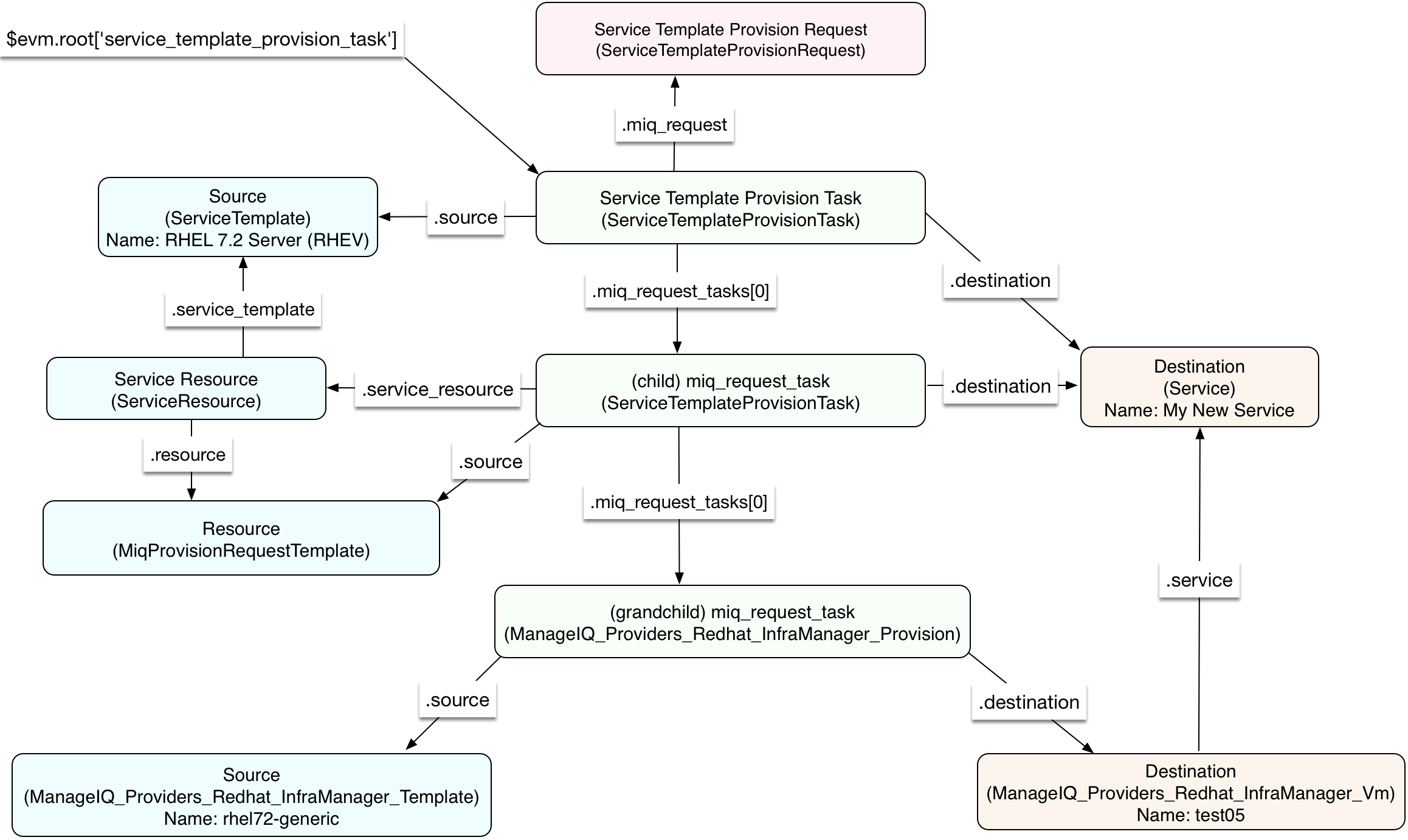{ 'MiqAeServiceServiceTemplateProvisionTask': ['source',
'destination',
'miq_request',
'miq_request_tasks',
'service_resource'],
'MiqAeServiceServiceResource': ['resource','service_template'],
'MiqAeServiceMiqProvisionRequestTemplate': ['source','destination'],
'MiqAeServiceManageIQ_Providers_Redhat_InfraManager_Provision': ['source','destination'],
'MiqAeServiceManageIQ_Providers_Redhat_InfraManager_Vm': ['service'] }Service Objects
We saw in VM Provisioning Objects that provisioning operations always include a request object, and a task object that links to source and destination objects.
When we provision a virtual machine from a service there are many more objects involved, because we are creating and referencing more items (creating both a service and potentially several new component VMs). When we provision from a service bundle, there will be several individual items to provision as part of the bundle. Even when we provision from a single service item however, the objects are structured as if we were provisioning a bundle containing only one item.
In this chapter we will look at some of the objects involved in provisioning a single VM from a service catalog item. The objects are visible to us during the processing of the CatalogItemInitialization state machine.
For this example:
-
We are using CloudForms 4.1
-
The provider is RHEV
-
The service catalog item name that we’ve ordered from is called "RHEL 7.2 Server (RHEV)"
-
The service catalog item was created to clone from a RHEV template called "rhel72-generic"
-
The new service name is "My New Service"
-
The resulting service contains a VM called test05.
We can use object_walker with the following walk_association_whitelist to dump the objects:
We’ll call the object_walker instance from the post5 state/stage of the CatalogItemInitialization state machine.
Object Structure
We can illustrate the main object structure in Service Object Relationship (some objects and links/relationships have been omitted for clarity).

Service Template Provision Task
Our entry point into the object structure from $evm is to the main ServiceTemplateProvisionTask object. We access this from:
$evm.root['service_template_provision_task']From here we can access any of the other objects by following associations.
Source
accessed from:
$evm.root['service_template_provision_task'].sourceThis is the ServiceTemplate object representing the service catalog item that has been ordered from.
Destination
accessed from:
$evm.root['service_template_provision_task'].destinationThis is the Service object representing the new service that will be created under My Services.
Service Template Provisioning Request
accessed from:
$evm.root['service_template_provision_task'].miq_requestThis is the initial ServiceTemplateProvisionRequest object that was created when we first ordered the new service. It is the request object for the entire service provision operation, including all VMs created as part of the service. This request object has associations to each of the task objects involved in assembling the service, and they in turn have backlinks to this request object.
Child miq_request_task
accessed from:
$evm.root['service_template_provision_task'].miq_request_tasks.each do |child_task|This is also a ServiceTemplateProvisionTask object, and is the task object that represents the creation of an item for the new service. There will be a child miq_request_task for each item (e.g. virtual machine) that makes up the final service, so for a service bundle containing three VMs, there will be three child miq_request_tasks.
Service resource
accessed from:
child_task.service_resourceThis ServiceResource object stores details about this particular service item, and its place in the overall service structure. A ServiceResource object has attributes such as:
service_resource.group_idx
service_resource.provision_index
...
service_resource.start_action
service_resource.start_delay
service_resource.stop_action
service_resource.stop_delayThese are generally zero or nil for a single-item service, but represent the values selected in the WebUI for a multi-item service bundle (see Service Object Relationship).

The service resource has a relationship to the ServiceTemplate object via child_task.service_resource.service_template.
Source
accessed from:
child_task.sourceor
child_task.service_resource.resourceThis is the MiqProvisionRequestTemplate object that describes how the resulting VM will be created. The object looks very similar to a traditional VM provisioning request object, and contains an options hash populated from the dialog options that were selected when the service item was created (e.g. placement options, memory size, CPUs, etc).
Destination
accessed from:
child_task.destinationThis is the same Service object that is accessible from $evm.root['service_template_provision_task'].destination.
Grandchild miq_request_task
accessed from:
child_task.miq_request_tasks.each do |grandchild_task|This is an ManageIQ_Providers_Redhat_InfraManager_Provision miq_request_task object, and is the task object that represents the creation of the VM. This is exactly the same as the task object described in [vm-provisioning-objects].
It is the grandchild miq_request_task that contains the options hash for the VM to be provisioned; this being cloned from the options hash in the MiqProvisionRequestTemplate object. If we have a service dialog that prompts for properties affecting the provisioned VM (such as VM name, number of CPUs, memory, etc.), we must pass these dialog values to the grandchild task options hash.
Source
accessed from:
grandchild_task.sourceThis is the ManageIQ_Providers_Redhat_InfraManager_Template object that represents the RHEV template that the new VM will be cloned from.
Destination
accessed from:
grandchild_task.destinationor
grandchild_task.vmThis is the ManageIQ_Providers_Redhat_InfraManager_Vm object that represents the newly created VM. This VM object has an association service that links to the newly created service object.
Summary
In this chapter we’ve taken a detailed look at the various objects that are involved in provisioning a virtual machine from a service. This is the object view from any method running as part of the service provision state machine.
The lowest layer of objects in Service Object Relationship - the grandchild miq_request_task with its source and destination objects - correspond to the virtual machine provisioning objects that we discussed in VM Provisioning Objects. When the service provision state machine hands over to the VM provision state machine, these are indeed the objects that are referenced at this latter stage, just like any other VM provision workflow. Any VM provision state machine methods that we may have written that access the attributes of these objects will see no difference. The only change is in the type of request object; $evm.root['miq_provision'].miq_provision_request will in this case be a service_template_provision_request object.